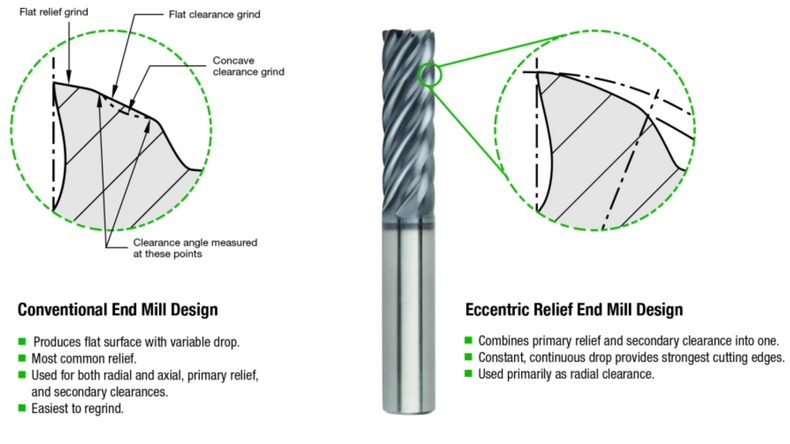
Conventional and eccentric end mill relief refer to the way the grinding removes material on the shank of the end mill, creating space for chip evacuation and preventing rubbing during cutting. Here's a breakdown of the key differences:
Conventional Relief:
- Most common design: This is the standard relief found in most end mills.
- Two-part grind: It has a primary relief, which is a flat or concave surface closest to the shank, followed by a secondary clearance, which creates a steeper angle at the cutting edge.
- Pros:
- Easier to regrind for sharpening.
- More versatile, suitable for both axial (plunging) and radial (sideways) cutting.
- Generally more affordable.
- Cons:
- May have a weaker cutting edge compared to eccentric relief for heavy cuts.
- Chip evacuation might be less efficient due to the sharp transition between primary and secondary relief.
Eccentric Relief:
- Continuous grind: It features a single, continuous, arched surface throughout the relief area, creating a convex shape close to the cutting edge.
- Pros:
- Stronger cutting edge: Offers greater strength due to thicker material at the cutting edge, ideal for heavy-duty applications.
- Improved chip flow: The continuous arc promotes smoother chip evacuation.
- Cons:
- More challenging to regrind: Requires specialized equipment and expertise due to the complex geometry.
- Limited application: Primarily used for radial cutting due to the lack of a sharp secondary clearance for plunging cuts.
- Generally more expensive compared to conventional relief.
Choosing the right relief:
The choice between conventional and eccentric relief depends on several factors, including:
- Material: Eccentric relief is better for harder and more abrasive materials due to its strength.
- Application: Conventional relief offers more versatility, while eccentric excels in heavy-duty radial cutting.
- Budget: Conventional relief is typically more cost-effective.
Remember, consulting manufacturers' recommendations and considering your specific machining needs is crucial for selecting the most suitable end mill relief type.


